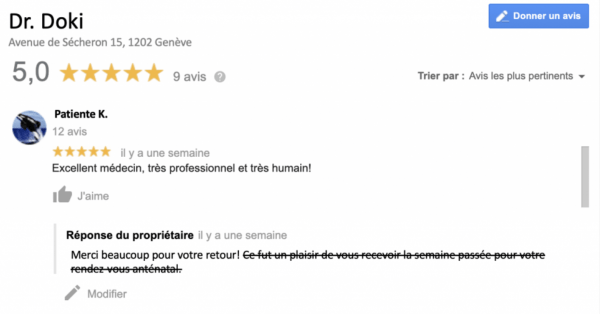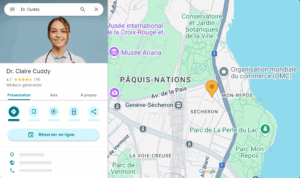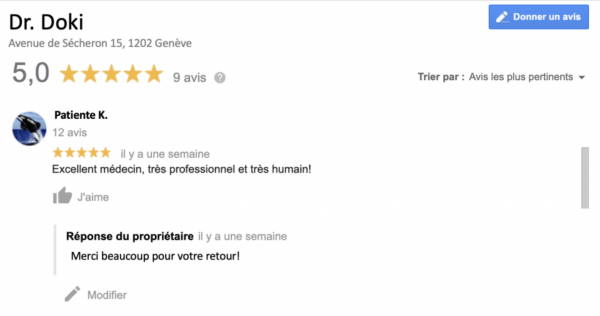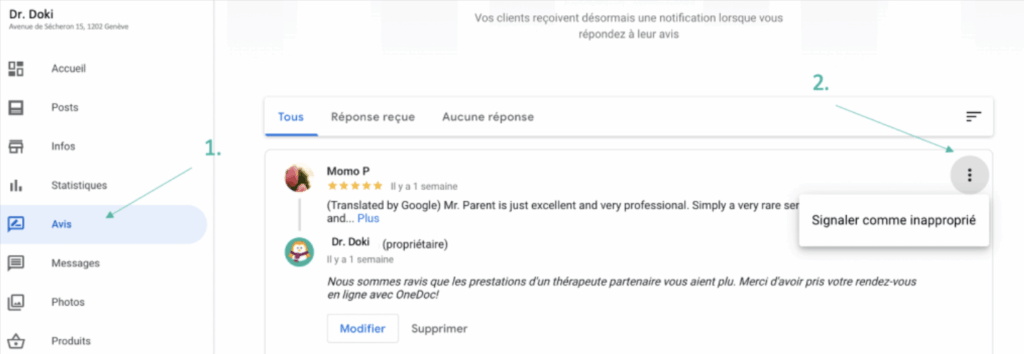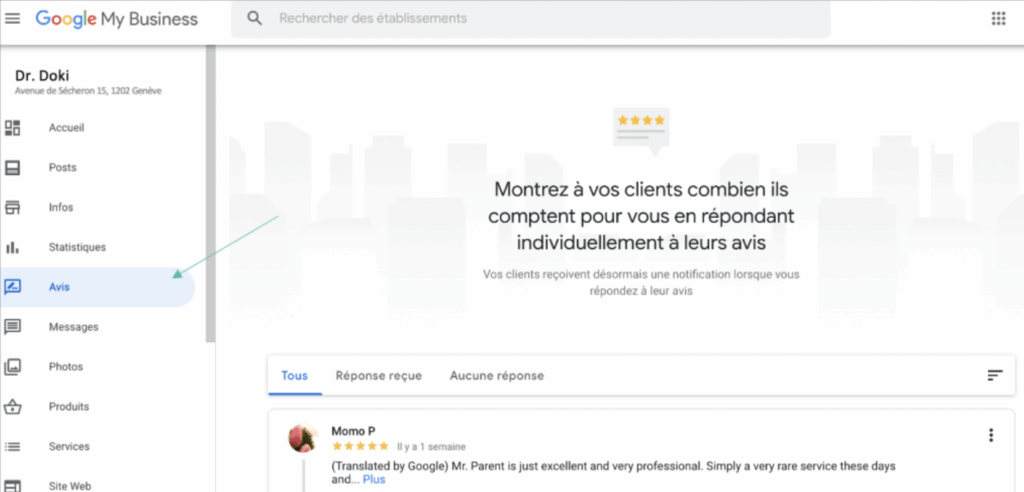
Online reviews have become a must‑check when finding a healthcare professional in Switzerland. Beyond simply managing your online reputation, responding to online reviews is an excellent way to be chosen by patients. The good news: even negative reviews can become an opportunity if you know how to respond professionally. In this article, we give you 5 tips for responding to reviews on Google and other online platforms, as well as ready‑to‑use response templates.
why you should manage your reputation and respond to reviews online
According to a study we conducted in partnership with MIS Trend and Farner, online reviews have become a reflex for choosing a healthcare professional in Switzerland, particularly on Google for more than 60% of the population. Google makes it easy to compare different healthcare professionals based on their ratings and comments left on their Google Business Profile. Having a sufficiently high rating (ideally above 4.2) and positive reviews is therefore essential for managing your online reputation!
tip #1: respond to all reviews, even negative ones
Ignoring a negative review leaves room for interpretation. Responding shows you are listening to your patients and can contribute to improving your online reputation.
Regardless of the site (Google, Facebook, LinkedIn, etc.), we recommend:
- Respond promptly to all reviews, whether they are positive, neutral or negative
- Maintain a courteous and professional tone. No personal attacks — always remain kind, even in the face of negative feedback.
- Acknowledge the patient’s feelings (without accepting it all)
- Keep it short: If the review doesn’t require context (for example if it’s positive), 3 to 5 lines will suffice.
Goal: Mainly reassure future patients rather than just the person who left the comment. The idea is to build trust so that patients decide to book with you. Responding professionally to all reviews gives a strong image of your practice and shows you care about your patients.
tip #2: protect medical confidentiality
Even if the review is unfair, or if you’d like to add some context to “defend” yourself, medical confidentiality always comes first.
Avoid in your responses:
- Mentioning the pathology, examinations, treatments
- Recalling a specific date or elements of the medical file
- Invoking the patient’s private life
Preferred phrasing:
- “your consultation”, “your care”, “your appointment”
- “We place great importance on welcome and organisation…”
Feel free to invite continued discussion privately by email or telephone rather than through a public review.
Goal: Respect medical confidentiality and the laws in force in Switzerland.
tip #3: turn constructive criticism into improvement
Not all negative reviews are necessarily problematic. Some point out very concrete areas for improvement: waiting times, reception, difficulties reaching the practice, etc.
In those cases, the best strategy is simply to take them into account and communicate that to your patients. You can briefly explain what you are doing or will do to improve the situation described and optionally offer direct contact (phone or email) to discuss further improvements.
Useful phrasing:
- “We are sorry to learn that your experience did not live up to your expectations.”
- “Your feedback helps us improve our practice’s organisation.”
- “Please feel free to contact us at [number] to discuss further.”
Goal: Show that you are responsive and able to reflect on your processes.
tip #4: handle abusive or clearly false reviews
While some reviews are simply negative, others go too far: insults, defamatory comments, someone who was never a patient… At this point, you’re not dealing with a standard critique but a violation of personality rights.
In these cases, you are entitled to report the review on the relevant platform (Google, social networks, etc.). This way the post can be removed and the review will not be counted. Note that this is not possible for reviews you merely dislike but only those that are defamatory or that contain private information.
If it’s not one of those cases, don’t waste time writing a long response: your priority is to request removal if the review is clearly out of line.
tip #5: organise yourself to respond quickly without spending your days on it
So that managing reviews doesn’t become yet another burden, the key is to have a simple method. To this end, you can follow these few best practices:
- Appoint a person or team in charge who monitors and replies to reviews
- Set a short turnaround: for example, reply within 24–48 working hours.
- Create some standard response templates (positive, negative objective, abusive/false, review without comment) which you personalise as needed. You can use the examples in the next section to help you.
To avoid discovering a review too late, we recommend activating notifications on your various accounts. Usually this is on by default. For Google, simply sign up here.
ready‑to‑use response templates for reviews
how to structure a standard response to a review?
Whether the review is positive or negative, the basic structure of your response can remain the same. This saves you time and ensures a consistent tone across all your profiles (Google, social networks, etc.).
Here’s a simple structure in 5 steps:
- Personalised greeting
Use the person’s name or title when it appears in the review.
Example: “Dear Mrs Schneider” - Thank‑you
Show that you appreciate the person took the time to leave a review.
Example: “Thank you for taking the time to share your experience.” - Acknowledge the feeling or situation
For a positive review, express your satisfaction. For a negative review, acknowledge the patient’s feeling, even if you don’t agree with everything.
Examples:
Positive: “We are delighted to learn that you felt well cared for.”
Negative: “We are sorry to learn that your experience did not live up to your expectations.” - Key message or general explanation
Re‑emphasise your priorities (quality of care, welcome, organisation…) and if needed mention a planned improvement without going into medical detail.
Example: “We place great importance on welcoming our patients and your feedback helps us improve our organisation.” - Offer direct contact and closing courtesy
Offer further discussion via a private channel (phone, email, appointment), especially in case of negative review, then end with a polite closing.
Example: “For reasons of confidentiality, we cannot discuss your situation here. Please feel free to contact us at [number] or via email at [address] so we can talk further.”
“With kind regards,
[Name of practitioner/cabinet]”
You can adapt these responses according to the usual tone you use on your different communication channels.
template response for a positive review
« Dear Mrs / Mr [Name],
Thank you very much for taking the time to leave this review. We are delighted to learn that you felt well cared for in our practice.
Your feedback encourages us to continue improving the quality of our reception and care.
With our best regards, [Name of practitioner / practice] »
template response for a negative review
« Dear Mrs / Mr [Name],
Thank you for sharing your experience. We are truly sorry to learn that your visit to our practice did not live up to your expectations, particularly regarding [reason (if it doesn’t compromise medical confidentiality, for example: the waiting time)].
We place great importance on the quality of care and on the organisation of our consultations. Your feedback will help us improve these aspects.
With our kind regards,
[Name of practitioner / team] »
retain control of your reputation by responding to online reviews
Responding to negative reviews is never pleasant, but it has become a key element in your relationship with patients. By remaining professional and respectful of medical confidentiality, you can turn sometimes difficult comments into improvement opportunities and proof of your seriousness for future patients.

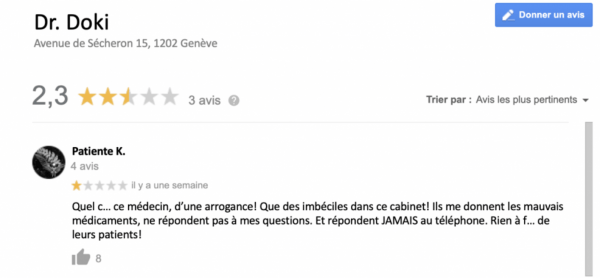
 How good is your digital presence right now?
How good is your digital presence right now?